Author Guidelines
The contribution (article, references, summary, notice) should not exceed 30,000 characters/6000 words (including notes and spaces).
Language: French
The contribution should be sent as an attachment in the .doc format to the following address: quetes-litteraires@kul.pl
Articles should be written in the Times New Roman font.
Authors/Affiliation/Title
The first and last name of the author: Times New Roman 12, lower case, left justified.
Affiliation: Times New Roman 12, lower case, left justified.
Title: Times New Roman 14, bold, lower case, left justified.
Text
- levels of text
The article is divided into sections marked by subtitles as follows:
- Times New Roman 12, bold.
1.1. Times New Roman 12, bold.
1.1.1. Times New Roman 12, bold.
The titles of the sections are left justified and numbered sequentially. Do not insert a full stop “.” after the title.
- running text
Font: Times New Roman, point type: 12, spacing: 1,5, justified, indentation: 1,25cm.
Page numbering: page numbers at the right bottom.
For emphasis, terms of foreign provenance, meta-language etc: use italics.
Short citations should be indicated in double quotation marks « … ». Long citations (more than 3 lines) have to be placed separately from a new line, one space above and below, indented by 1,25cm and written in 10 point type.
Footnotes should numbered sequentially and be in the Times New Roman font and 10 point type. Punctuation marks in the running text should always be placed after the superscript indicating the footnote.
Illustrations, charts, figures, tables (in limited quantities) should be placed in the text. They should be numbered starting with 1 and captioned (e.g. Table 1 … Figure 1 … etc.) . Figures and charts should be in the .jpg format and pasted into the text as pictures.
References should be indicated in the running text as follows: (Author, Year, page) e.g. (Gross, 1969, p. 323) or (Year, page) e.g. Gross (1969, p. 323), if the authors name has appeared in the text.
Bibliography (marked by the heading RÉFÉRENCES, Times New Roman 12, capitalised) should be placed at the end of the article in alphabetical order.
Please, use APA style.
French adaptation of APA style:
http://benhur.teluq.ca/spersonnel/mcouture/apa/index.htm
The following conventions should be observed:
Book
name (lower case), + intial of the author’s first name. (Year). Title. Place : Publisher.
e.g. Omesco, I. (1978). La métamorphose de la tragédie. Paris : Seuil.
Article in book
name (lower case), + intial of the author’s first name. (Year). Title of Article. In name of editor. Title of book. (Page numbers of article). Place : Publisher.
e.g. Hamon, Ph. (1977). Pour un statut sémiologique du personnage. Dans R. Barthes et W. Kayser (dir.), Poétique du récit (p. 115-171). Paris : Seuil.
Article in journal
name (lower case), + intial of the author’s first name. (Year). Title of Article. Title of journal, Number of Issue, Page numbers of Article.
e.g. Dabezies, A. (2004). Mythes anciens, figures bibliques, mythes littéraires. Revue de littérature comparée, 309(10), 3-22.
Website
e.g. Alix-Leborgne V. (2011). La folie chez Émile Zola et Hector Malot. Perrine, revue de l’Association des amis d’Hector Malot. Récupéré de https://www.amis-hectormalot.fr/revue-perrine/revue-perrine-2011.
At the end of the text: the title of the article, summary (150 words) and 4-5 keywords in French and English together with a short note containing the affiliation, address and ORCID iD.
Example:
Catherine Duras – professeur, maître de conférences à l’Institut de Philologie Romane de l’Université Catholique de Lublin Jean-Paul II. Adresse de correspondance : Institut de Philologie Romane de l’Université Catholique de Lublin Jean-Paul II, Al. Racławickie 14, 20-950 Lublin, Pologne ; e-mail : cduras@gmail.com
ORCID iD: ...
Plagiarism checker software
The editorial team uses the "iThenticate" plagiarism checker software to verify the originality of texts submitted for publication in "Quêtes littéraires".










